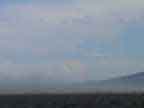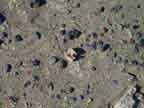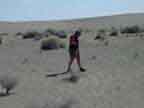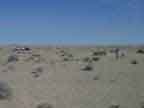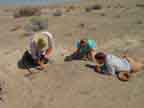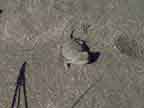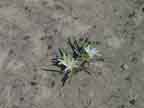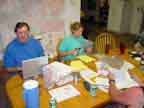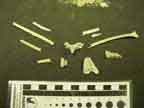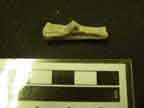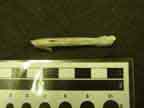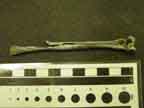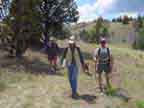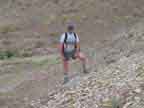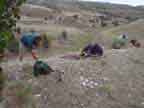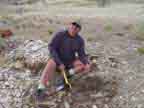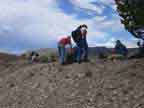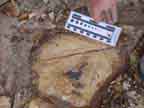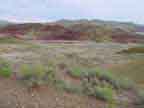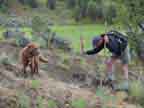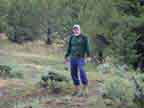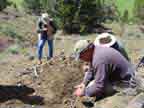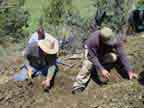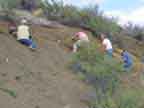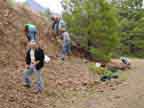Search and Rescue Report |
5/17/2006 to 5/21/2006 |
| Wednesday, May 17th: I woke up way to early and just couldn't get back to sleep so I loaded up the truck and headed off to pick up my brother for the first leg of the trip. Driving slow didn't burn up enough time so I stopped by Fred Meyer's to pick up additional supplied. Unfortunately they where closed so I spent 30 minutes in the parking lot smoking cigarettes and listening to Johnny Cash. I arrived at Steven's house on time and after loading up his gear we were off.
It seemed like it took forever to get out of town but once we were past Sandy it felt like the trip had begun. It was a beautiful sunny morning and the drive through the Cascade Range was great. In no time we where through Madras, Redmond, and Bend. After a quick stop in La Pine for fuel we headed East to Christmas Valley to meet up with Dr. Martin and several graduate students from SDSM&T. We arrived at the Fort Rock Guard Station and Dr. Martin and crew where still in the field so we decided to check out near by Derrick Cave. The road to the cave cuts through a farm, where a few "No Trespassing" were posted. Not knowing this area we opted not to proceed and stopped at a near by Juniper trees to eat lunch. We later found out that it's OK to drive through the farm to access Derrick Cave. After lunch we headed to Fort Rock, which is one of our favorite geologic features in Oregon. Fort Rock is a shield volcano set in what was a shallow lake over 100,000 years ago. Even with temperatures nearing 100 degrees we set out to hike around the volcanic cone. I was in search of a photo opportunity to capture wave erosion that can be seen high upon the crater wall. Steven was out to enjoy the scenery and work on his tan. It wasn't long after making our way back to the Guard Station that Dr. Martin returned. Most of what is found at Fossil Lake are bone fragments and Steven and I were enlisted to glue many of the specimens back together. After the specimens where cataloged and plans made for the following day we call it good and headed sleeping bags. Thursday, May 18th: It was another very early morning for me. My cot was setup outside near a BBQ pit that some critter was rattling around in all night and the birds started singing around 4am. I really wish they could have at least waited until the sun was up. Around 8am we headed out and followed Dr. Martin and crew to Fossil Lake. Today's activities included fossil collecting and coring at a few localities. Collecting entailed walking grid patterns over specified areas about 100' x 100' and the first area produced a few specimens. I've seen Fossil Lake material in the past and it has always been jet black and rings like glass. Much of what we found was off white and looked similar to contemporary bones, in fact my first few great discoveries probably weren't more that a few years old. I had better luck at the second search area and found a few lagomorph (rabbit) bones, which were placed in specimen vials and labeled with the stratigraphic layer they where found in. The temperature was getting closed to 90 degrees and it wasn't even 11am yet. Steven and had an early lunch then set back out collecting. We brought along a screen box and gave it a try. An hour's work only produced one bird vertebra so we decided to go back to walking grid patterns. It wasn't long before Steven called me over on the two-way radio to see what he had found. At his feet lay the remains of numerous bird bones from a single specimen. It really looked like a bird took a header into the ground and exploded. We ran across Dr. Martin and showed him Steven's bird. He was excited about this find since it was one of only a few found in the particular layer we were collecting. At the site we recovered a few more bone fragments and headed back to the trucks due to threatening weather. On the way back I picked up a few more bird bone fragments. They didn't have any diagnostic features that I could see so I was thinking about tossing them back on the ground. Dr. Martin asked what I had and I just shrugged and handed them over. "What you have here is a bird beak" said Dr. Martin. It didn't look like one to me until he put the pieces together and pointed out the details of the beak, which was about 2.5" long. We made it back to the truck just as the thunderstorm hit. The one thing that freaks me out the most is lightening, after that it would be ticks. I was glad to be in the truck when the sky started to light up around us but it was a small T-storm and after 20 minutes of rain the storm passed and we headed back out to collect. Steven and I had little luck collecting the remainder of the day and most of the time I was looking over my shoulder at another approaching storm. Dr. Martin asked if it was going to rain and I said no. It really looked like it was going to pass us to the West. It wasn't long after I could see that it was moving our way. I was about a half mile from the truck so I started to head back and just as I reached the safety of the truck (at least to me) it was flash, boom, bang all at once. Steven and I spent the next 15 minutes in awe of the heavy rain, hale, and strong winds, not to mention the great light/sound show that was around us. Dr. Martin and crew must have hunkered down under some sage or behind a sand dune, as they were nowhere in site. Steven and I started collecting again and I was working my way back to where Dr. Martin was before the storm. I finally seen them walking back to the vehicles and we caught up with them at the truck. Dr. Martin was pretty excited about one students find of a bone and teeth fragments of a juvenile bear. Apparently it is only the 2nd bear found at Fossil Lake, which has been collected for more than 100 years. Back at camp we had a quick shower and started dinner. Over the next few hours I glued the bird beak and a few other bones together while Dr. Martin was passing bird bones to Steven to ID with the aid of an Avian Osteology book. We had an early departure time in the morning so around 10pm we said our goodbyes and hit the sack. I really want to thank Dr. Martin for allowing Steven and I the opportunity to participate with the research that is taking place at Fossil Lake. Friday, May 19th: It was another very early morning for me. Ya, I know I said that before. I was still awake a few hours after crawling into the sleeping bag last night watching an amazing lightening show that surrounded us 360 degrees. Plus the birds were back at it at 4am, Oh, and the sunburn on my arms and shoulders limited me to sleeping on my back. After coffee and packing up we were on the road again to Mitchell, OR to hook up with several other NARG members. It was about 180 miles from Christmas Valley to Mitchell and we had camp setup by 10:30am. Around 1pm Steven, Robert, Skip, Tim and I where off to collect Bridge Creek Flora from the John Day Formation and it wasn't long after we made it to the site that Jim, Bill, and Mike showed up. An hour into collecting I found a cute little Metasequoia cone, which is the first one I've ever found. Steven found a huge leaf that must measure at least 8" across. It came out in several pieces and the outer margins of the leaf are missing but it's one of the largest leaf specimens I've seen from this locations and I can't wait to get it identified. The rain must have followed us up from Christmas Valley as storm clouds where approaching. The wind really picked up as well it must have been gusting to near 35 mph. A few of us decided to head back to camp so we loaded up our packs with some classic examples of Bridge Creek Flora. Camp was pretty wet when we returned and I was sure glad I pitched a tent. The only reason I brought the tent was for shelter from the sun but it was turning out to be one of the wettest trips to Central Oregon I ever been on. We got a nice fire going but after a few hours steady rain settled in so we called it a night and crashed around 10pm. Saturday, May 20th: It was another very early morning for me. My sunburn well.... burned all night but the primary reason for lack of sleep was a nasty thunderstorm that rolled in right after crawling into the sack. The lightening really didn't bother me but it was the amount of rain that was coming down and the fact that we camped about 30' off of Bridge Creek. Usually this time of year you can step across the creek but it was already three times it size from the day's previous rain and all I could think about was flash flood. Camp was still in tacked when I woke up and Bridge Creek was about a foot higher and looked like chocolate milk. On the plus side the cloud layer was thin and it looked like it was going to finally be a decent day. After breakfast we headed out to a fairly new locality for us to collect ammonites from the Hudspeth (Cretaceous) Formation. After checking in with the landowners we hit the hillside in search for ammonites that have weathered out over the winter. The area we collected is in the basal member of the Hudspeth Formation with some Permian conglomerate rocks exposed as well. By lunch I had a dozen or so small ammonites, gastropods and bivalves and was ready to check out another locality. Most of what is collected in this area is float and we rarely dig. Bill managed to find an ammonite mortality layer that produced several pieces of matrix with 5 to 10 ammonites embedded. I couldn't pass this up so we headed over and spend an hour digging in search of our own mortality plate. Unfortunately for us Bill must have found all there was to be found and we only ended up with a few ammonite fragments. On my way to the truck I ran across two huge snakes on the trail. Anytime I run across a snake in this area of Oregon it's a little startling but after closer examination they where only Gopher Snakes and not rattlers. While waiting for the rest of the group I checked out a nearby hillside. It wasn't long until I heard someone yell and sure enough someone else crossed the path of the Gopher snakes. The next stop was not as fruitful as the first. There were ammonite fragments to be found but not much in the way of a complete specimen. While everyone else continued to search the hillside I headed off prospecting new localities but came back empty handed. We ended up checking out two other localities but they only produced two ammonites but one was a beautiful 6" specimen that Steven found in a concretion. It was a long day and after 9 hours in the field we headed back to camp. The sky was cloud free and it looked like it was going to be the first night without rain. We sat around the fire and talked fossils most of the night and planned for the next month's trip. Sunday, May 21st: Wow, my first good nights rest but I was still up early. The clouds rolled in over night and it looked like we where having coastal weather rather than something you'd expect in the high desert. We broke down camp quickly as a few raindrops fell and headed off to our final location to collect Clarno (Eocene) Flora. The site is a tough one to collect. You really have to put some effort into getting a decent specimen from this site. Most of what you find is leaf hash and a complete specimen is almost unheard of. In the past I really wasn't prepared but this time I came armed with a few chisels, 3lb crack hammer and pry bar. Steven and I got started and worked downs through 2 ft of sandstone matrix to get to the finer grained where the better leaf specimens are found. After an hour we had a 3'x3' area cleared. We did find a few nice highly carbonized leaf imprints that where 70%-85% complete but for all our work we where hoping for more. We decided to go down through another 2ft of sandstone to get to the next leaf-producing layer but found more of the same. I can't say that I'm completely disappointed because we did get some nice sized chunks of matrix with some of the finest material from this particular site. I guess we just get spoiled with the quality of the Bridge Creek Flora. The rain was pretty steady by now so Steven and I said our goodbyes to the rest of the group and headed home. |
| ©2004 NARG - North America Research Group |


